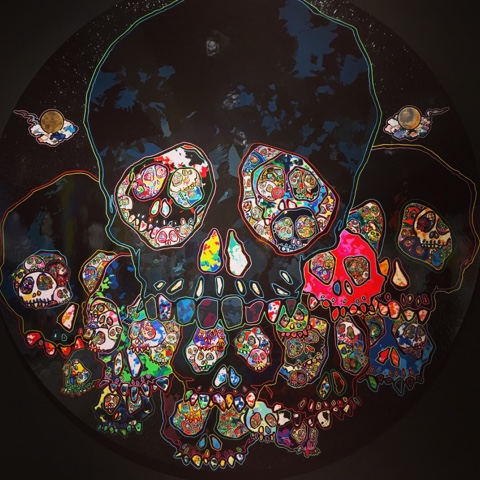Kapag nababanggit ang Gifu, karaniwang pumapasok sa isip ang UNESCO World Heritage Site na Shirakawa-Go na matatagpuan sa hilagang bahagi nito. Binubuo ito ng mga lumang Gassho-styled houses na napanatiling maganda at maayos sa loob ng mahabang panahon. Bukod dito, mayaman sa kasaysayan ang Gifu. Maraming lugar dito ang minsang naging sentro ng mga castle towns noong 1500s. Isa sa masasabing kayamanan ng Gifu ay ang Gifu Castle na makikita sa tuktok ng Kinkazan.
Ang Gifu Castle
Ang Gifu
Castle ay orihinal na itinayo ng pamilyang Nikaido noong 1200s. Naging higit na
kilala ito dahil dito namalagi si Oda Nobunaga, isang daimyo o feudal lord
noong 1500s, sa loob ng siyam na taon bago siya lumipat ng Azuchi Castle sa Shiga.
Dahil sa magandang lokasyon at istilo ng pagkakagawa ng castle town, naging
modelo ito sa iba pang mga itinayo noong panahon na iyon. Mula sa tuktok ng
castle makikita ang napakagandang view ng Gifu City, ang kahabaan ng Nagara
River at ang mga bundok na nakapaligid sa Gifu. Hindi mo mapipigilang mamangha
sa ganda ng tanawin at mapapaisip kung paano naitatag ng mga sinaunang tao ang
castle na ito sa tuktok ng bundok.
Upang makapunta sa Gifu Castle, maaaring sumakay ng Kinkazan Ropeway na tumatagal lamang ng tatlong minuto. Ang istasyon nito ay matatagpuan sa Gifu Park na nasa paanan ng Kinkazan. Bawat 15 minuto ay mayroong biyahe ang ropeway paakyat at pababa ng bundok. Para naman sa mga mas gustong akyatin ang bundok, mayroon din na mga hiking trails na maaaring sundan paakyat.
Sa labas ng Gifu Castle makikita ang Gifu Castle Archives Museum na nagtataglay ng ilang mahahalagang artifacts mula sa Gifu Castle. Makikita rito ang ilang lumang sandata, baluti at helmet na ginamit noong 1500s. Kasama na sa ticket ng Gifu Castle ang pagpasok sa museum na ito.
Makikita naman pagbaba ng ropeway sa tuktok ng Kinkazan ang Squirrel Village. Ito ay tila maliit na zoo na puro squirrel lamang ang kanilang inaalagaan. Maaari mong pakainin ang mga squirrel sa iyong kamay. Mababait ang mga squirrel at hindi takot sa mga tao. Mayroon din na mga staff na palaging nagbabantay kaya walang dahilan upang matakot sa pakikipaglaro sa mga squirrel. Mayroon din pinapahiram na gloves upang protektahan ang iyong kamay habang pinapakain ang mga ito.
Matatagpuan
rin na nakakalat sa iba’t ibang lungsod sa Gifu ang mahigit kumulang 13 pang
castle. Ang ilan dito tulad ng Kiyosu Castle, Ogaki Castle at Sunomata Castle
ay nagkaroon ng mahalagang papel sa Battle of Sekigahara noong 1600.
Ang Gifu Park
Ang Gifu
Park ay isang malaking parke sa paanan ng Kinkazan kung saan maaaring mamasyal
at magpahinga habang pinagmamasdan ang iba’t ibang halaman at bulaklak sa
paligid. Makikita rin dito ang iba’tibang atraksyon tulad ng:
Gifu
City Museum of History. Dito malalaman ang mayamang kasaysayan at paraan ng
pamumuhay sa Gifu. Makikita rin dito ang ilan sa mga tradisyunal na produkto ng
Gifu at mga lumang artifacts na nahukay sa ilang bahagi ng Gifu na tinatayang
ginamit pa ng mga sinaunang nanirahan sa Gifu may ilang libong taon na ang
nakakalipas. Mayroon din ditong replika ng free market na pinasimulan ni Oda
Nobunaga noong 1500s.
 Nawa
Insect Museum. Ang museum na ito ang unang insect museum sa buong Japan.
Pinasimulan ito ni Yasushi Niwa, ang nakadiskubre ng isang uri ng paru-paro na
matatagpuan sa Gifu na binansagang “Gifu Butterfly.” Makikita rito ang halos
300,000 specimen ng 18,000 uri ng insekto.
Nawa
Insect Museum. Ang museum na ito ang unang insect museum sa buong Japan.
Pinasimulan ito ni Yasushi Niwa, ang nakadiskubre ng isang uri ng paru-paro na
matatagpuan sa Gifu na binansagang “Gifu Butterfly.” Makikita rito ang halos
300,000 specimen ng 18,000 uri ng insekto.Lokasyon ng dating tirahan ni Oda Nobunaga. Sa paanan ng Kinkazan matatagpuan ang ruins ng dating tirahan ni Nobunaga na ngayon ay binubuo na lamang ng mga natirang pundasyong bato.
Hindi man kasing kilala ng ibang lugar tulad ng Osaka at Kyoto, mayroon din na mga natatagong pasyalan ang Gifu na masayang tuklasin at bisitahin kahit anong panahong pa ito, mapa-spring man o winter pa.




















